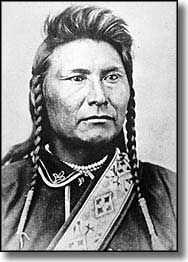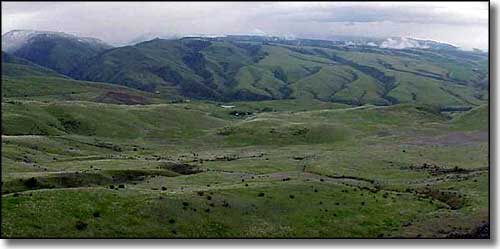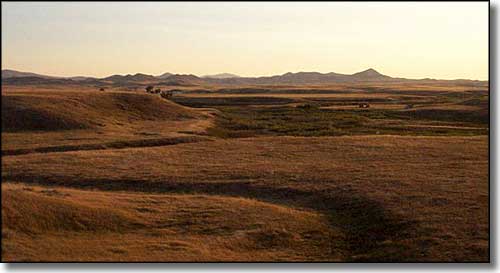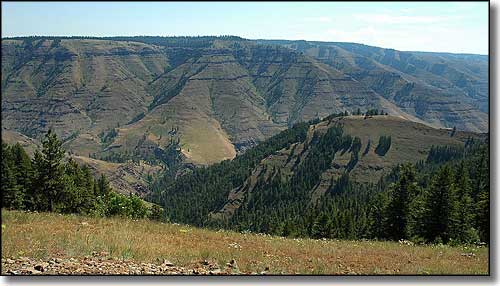 |
Nez Perce National Historic ParkWashington, Oregon, Idaho & Montana |
 Nez Perce Country |
|
"We fish in rivers our Grandfathers fished in long before the arrival of Columbus. We dig roots in meadows our grandmothers dug before the rise of the Roman Empire. We live in the place our ancestors called home before the Great Pyramids of Egypt were built. We did not travel here; we are of this land. We did not declare our independence; we have always been free." - Nez Perce Tribal Executive Committee |
 Chief Joseph This is the story of an epic "Freedom Flight," because throughout the saga, the Nez Perce fought in a purely defensive manner. The 750-or-so (maybe 250 of which were actually warriors) Nez Perce who participated in the journey never acted aggressively against the 2,000 soldiers plus uncounted civilian volunteers and Nez Perce enemies. But they did act to defend themselves and their families. By the time it was over, about 300 Nez Perce were dead, greater casualties than even the Battle of Little Bighorn. Their entire effort had been simply to escape from their violated homeland to seek a new place where they might again be free to live their own peaceful lives. The Nez Perce were superb horsemen and warriors. The assistance they gave Lewis and Clark made the success of that epic journey possible. The Nez Perce were the first tribe in the Pacific Northwest to ask for missionaries. When their ancestral homelands were invaded and abused again and again by American miners and ranchers, they showed great patience while attempting vainly to get justice from the American Government. Finally, they couldn't take the abuse and broken promises any longer, they left their homelands in Oregon and Washington and headed east, then north, over their ancestral hunting trails with the US Army in hot pursuit. In June, 1877, several hundred (maybe 700 total, of which maybe 250 were warriors) Nez Perce followed Chief Joseph as he tried to make his way to Canada (they were hoping to at least get decent treatment and food fit to eat from the Canadians). When it was all over, General Sherman called this "the most extraordinary of Indian wars." Nez Perce National Historic Park is composed of 38 different sites scattered around Washington, Oregon, Idaho and Montana. The "big" sites are the Spalding Visitor Center (11 miles east of Lewiston, Idaho on US 95), the Big Hole National Battlefield (10 miles west of Wisdom, Montana on State Route 42) and the Bear Paw Battlefield (16 miles south of Chinook, Montana on Route 240). Nez Perce National Historic Park also includes 3 sites that were used by the Lewis & Clark Expedition in their journey to the Pacific in 1805 and 1806. (A word about the "battlefields:" these are actually places where the Army launched surprise assaults on unprotected groups of Nez Perce families while they were peacefully camped. Some of these attacks were on "treaty" Nez Perce and after they had repelled the Army, they joined with the "non-treaty" Nez Perce in their flight to Canada.) |
 White Bird Battlefield |
|
White Bird Battlefield (one of the Park sites in Idaho) is where the first battle of the Nez Perce War was fought. On June 17, 1877, the US Cavalry suffered 60 dead in their defeat here and the Nez Perce were forced to begin their long journey to find sanctuary and safety from a government that had never dealt honestly with them. On July 3 and 5, 1877, there were further skirmishes near Cottonwood, Idaho. On July 11, 1877, General Howard crossed the Clearwater River and attempted to take the Nez Perce by surprise. He failed, miserably. When the Nez Perce withdrew from Clearwater they went to Weippe Prairie, a root-gathering place they had frequented for many, many years. The tribes left Weippe Prairie shortly and went to Musselshell Meadow, then over the Lolo Trail and Lolo Pass (across the Bitterroots) into Montana. |
 Big Hole Battlefield Big Hole National Battlefield is the site of an attack (August 9, 1877) by the US Army on an encampment of Nez Perce. While the Army suffered 29 dead and 40 wounded, the Nez Perce suffered more than 90 dead (men, women and children) in the fighting. In spite of their losses, the Nez Perce warriors rallied and trapped Colonel Gibbon's men for 24 hours while the remainder of the Nez Perce families escaped. After withdrawing from the battlefield, the Nez Perce went to Camas Meadow (another ancient root-gathering site in Idaho) where they stole 200 of the Army's horses and pack mules, temporarily stopping General Howard's advance. When the Nez Perce left Camas Meadow, they traveled into what is now Yellowstone National Park and attempted to lose the following troops. But when they emerged on the east side of Yellowstone a few days later, the cavalry was still following. The main body of the Nez Perce kept moving northward but they left some warriors behind to engage the Army horsemen. These warriors successfully held the mounted troops up long enough for the main body of the tribe to disappear in the direction of the Crow Reservation. But as much as they were old friends and allies, the Crows lived supervised on an Army-occupied reservation and couldn't give them sanctuary, so the Nez Perce headed north and tried to reach Canada. They would have made it, too, if it hadn't been for extremely bad weather. |
 Bear Paw Battlefield |
|
Bear Paw Battlefield is the place in Montana where Chief Joseph surrendered his rifle to General Howard and ended the siege of his people in their encampment on Snake Creek. For 5 days, in a place with virtually no cover, they had fought Howard's cavalry and cannons to a standstill. Then came a heavy snowstorm. They were just 45 miles short of the Canadian border and what they had hoped would be their freedom. While Chief Joseph was negotiating with the Army, several families escaped with White Bird under cover of the blizzard and made their way across the border into Canada. In the 4 months since the fighting began, they had traveled 1,170 miles. The Army almost immediately transported the surrendered Nez Perce with Chief Joseph to Indian Territory in Oklahoma, but they were allowed to return to the Northwest in 1885. Chief Joseph died on the Colville Reservation in Washington in 1904. His grave is now a sacred place in a private cemetery. The Nez Perce War started because of flagrant abuse of the tribe's land by white settlers and the refusal of local law enforcement and the military to protect the tribe. There was also the problem of corrupt Indian agents giving the tribe spoiled flour and other food, and not even enough of that to meet the quotas guaranteed in the treaties: the Nez Perce were literally starving to death. If they had been allowed to go to those places where they had traditionally gone for years to get food in times of need, there wouldn't have been a problem. But the good white folks thought grazing cattle was more important than allowing starving Indians to feed themselves... |
   Joseph Canyon in Oregon |
|
|
 |
| Index - Arizona - Colorado - Idaho - Montana - Nevada - New Mexico - Utah - Wyoming National Forests - National Parks - Scenic Byways - Ski & Snowboard Areas - BLM Sites Wilderness Areas - National Wildlife Refuges - National Trails - Rural Life Advertise With Us - About This Site - Privacy Policy |
| Most photos of Nez Perce National Historic Park courtesy of the National Park Service Photo of White Bird Battleground courtesy of Phil Konstantin Photo of Joseph Canyon courtesy of Marc Shandro, CCA ShareAlike 3.0 License Text Copyright © by Sangres.com. All rights reserved. |